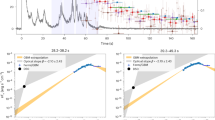Abstract
A quiescent X-ray source detected with the Einstein X-ray Observatory in a location consistent with that of an intense γ-ray burst1–3 is shown here to be also consistent with the location of the 1928 optical transient4, the likely optical counterpart of the γ-ray burst source GBS0117 – 29. The probable maximum X-ray luminosity is only ∼1031 erg s−1 and supports the hypothesis that either γ bursts are produced by accretion instabilities5,6 or, if due to published models for a thermonuclear flash7, they recur with intervals ≳50 yr. Such long recurrence times may be inconsistent with limits inferred from both the γ burst observations8 and optical data4.
This is a preview of subscription content, access via your institution
Access options
Subscribe to this journal
Receive 51 print issues and online access
$199.00 per year
only $3.90 per issue
Buy this article
- Purchase on Springer Link
- Instant access to full article PDF
Prices may be subject to local taxes which are calculated during checkout
Similar content being viewed by others
References
Cline, T. L. et al. Astrophys. J. Lett. 246, L133–L136 (1981).
Pizzichini, G. et al. Space Sci. Rev. 30, 467–470 (1981).
Pizzichini, G. et al. Proc. Paris Cosmic Ray Conf. XG 2.2–2, 40–44 (1981).
Schaefer, B. E. Nature 294, 722–724 (1981).
Lamb, D. Q., Lamb, F. K. & Pines, D. Nature phys. Sci. 246, 52–54 (1973).
Kafka, P. & Meyer, F. submitted to Gravity Research Foundation Competition (MPI Preprint 1981).
Woosley, S. in Gamma Ray Transients and Related Astrophysical Phenomena (eds Lingen-felter, R. E. Hudson, H. S. & Worrall, D. M.) 273–292 (American Institute of Physics, 1982).
Mazets, E. P. & Golenetskii, S. V. Astrophys. Space Sci, 75, 47–81 (1981).
Hjellming, R. M. & Ewald, S. P. Astrophys. J. Lett. 246, L137–L140 (1981).
Giacconi, R. et al. Astrophys. J. 230, 540–550 (1979).
Pizzichini, G. et al. Proc. Munich Conf. on Neutron Stars (in the press).
Maccacaro, T. et al. Astrophys. J. 253, 504–511 (1982).
Schaefer, B. E. & Ricker, G. R. Nature (submitted)
Pedersen, H. et al. IAU Circ. No. 3711 (1982).
Colgate, S. & Petschek, A. Astrophys. J. 248, 771–782 (1981).
Wallace, R. K., Woosley, S. E. & Weaver, T. A. Astrophys. J. 258, 696–715 (1982).
Lamb, D. Q. in Gamma Ray Transients and Related Astrophysical Phenomena (eds Lingenfelter, R. E., Hudson, H. S. & Worrall, D. M.) 249–272 (American Institute of Physics, 1982).
Jennings, M. L. & White, R. S. Astrophys. J. 238, 110–121 (1980).
Share, G. H., Wood, K., Meckins, J. & Yentis, D. J. in Gamma Ray Transients and Related Astrophysical Phenomena (eds Lingenfelter, R. E., Hudson, H. S. & Worrall, D. M.) 35–44 (American institute of Physics, 1982).
Hertz, P. & Grindlay, J. E. Astrophys. J. Lett. (submitted).
Author information
Authors and Affiliations
Rights and permissions
About this article
Cite this article
Grindlay, J., Cline, T., Desai, U. et al. Persistent X-ray emission from a γ-ray burst source. Nature 300, 730–731 (1982). https://doi.org/10.1038/300730a0
Received:
Accepted:
Issue Date:
DOI: https://doi.org/10.1038/300730a0
This article is cited by
-
On the binary nature of cosmic γ-ray burst sources
Nature (1985)
-
Size of a γ-ray burster optical emitting region
Nature (1983)
-
Constraints on γ-ray bursters from soft X-ray transients
Nature (1983)
Comments
By submitting a comment you agree to abide by our Terms and Community Guidelines. If you find something abusive or that does not comply with our terms or guidelines please flag it as inappropriate.



